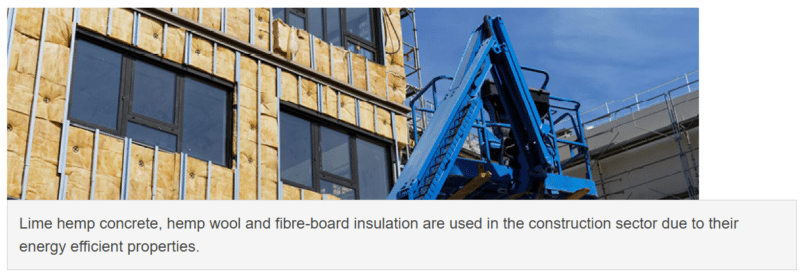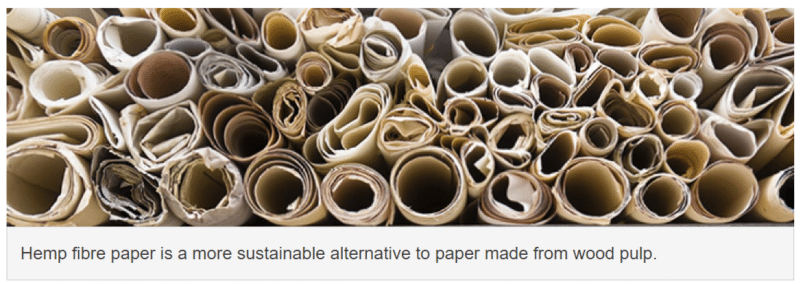Hemp production offers broad opportunities for farmers, industrial sectors and consumers in the European Union.
Hemp is a crop grown across Europe. In recent years the area dedicated to hemp cultivation has increased significantly in the EU from 20,540 hectares (ha) in 2015 to 33,020 ha in 2022 (a 60% increase). In the same period, the production of hemp increased from 97,130 tonnes to 179,020 tonnes (a 84.3% increase). France is the largest producer, accounting for more than 60% of EU production, followed by Germany (17%) and The Netherlands (5%).

EU land area used for hemp cultivation
1000 haEU land area used for hemp cultivation Source: Eurostat20.5420.5422.0122.01272728.0528.0534.9634.9634.5434.5431.5931.5933.0233.0220152016201720182019202020212022152025303540
Hemp cultivation contributes to the European Green Deal objectives
Hemp has a number of environmental benefits.
- Carbon storage: one hectare of hemp sequesters 9 to 15 tonnes of CO2, similar to the amount sequestered by a young forest, but it only takes five months to grow.
- Breaking the cycle of diseases: hemp helps to break the cycle of diseases when used in crop rotation. In addition, weeds are not able to grow due to the fast growth and shading capacity of hemp plants.
- Soil erosion prevention: dense leaves of hemp become a natural soil cover, reducing water loss and protecting against soil erosion. Hemp covers the ground just three weeks after germination.
- Biodiversity: flowering cycle usually occurs between July and September, coinciding with a lack of pollen production from other crops. Hemp produces large amounts of pollen. It also provides shelter for birds and hemp seeds are a food for animals.
- Low or no use of pesticides: hemp is susceptible to few pests because of the lack of natural predators, which means that the use of insecticides, herbicides, and fungicides can be avoided in most cases.
Related information
Uses of hemp
1. Textile industry (hemp fibre)
Hemp fibre is very similar to linen and the interest of the textile industry in using hemp fibre is growing. The European Commission, in its circular economy action plan, considers the textile sector as one of the cornerstones in the transition towards a greener and more sustainable economy and it has encouraged stakeholders to seek new materials and new economic models. To this end, the Commission will propose a comprehensive EU strategy for sustainable textiles aiming to create a more sustainable, innovative, circular economic model.

2. Food and feed (hemps seeds)
Hemp seeds contain high levels of protein and considerable amounts of fibres, vitamins, Omega-3, and minerals. As a result, de-hulled hemp seeds serve as a food for human consumption, while whole hemp seeds are used as feed for animals.
3. Construction (hemp fibre)
There are three main hemp-based products used in construction: lime hemp concrete (LHC), hemp wool, and fibre-board insulation. The construction sector is responsible for 40% of energy consumption and 36% of GHG emissions, and 75% of that energy goes to waste. This has led to a search for construction practices and materials that are carbon dioxide neutral or carbon sequesters. Hemp concrete is a carbon sequester as the amount of carbon stored in the material is higher than the emissions generated during its production, and it continues to store carbon during the building’s life. Improving energy efficiency in the building sector will play a key role in achieving carbon-neutrality by 2050, a goal set out in the European Green Deal. Hemp can play a significant role in reaching this objective.

4. Paper production (hemp fibre)
There are multiple advantages to using hemp fibre to make paper: hemp stalks only take up to five months to mature, hemp paper does not necessarily require toxic bleaching chemicals and hemp paper can be recycled seven to eight times.

5. Other uses
Hemp-derived products are used in different industries and for different purposes. Negative environmental effects of plastic have pushed manufacturers to seek alternatives. Hemp is a good option given its light weight and durability. As a substitute for plastic, hemp-derived products are used in different sectors such as car manufacturing, railway, aviation and aerospace.
Other uses of hemp include cosmetics (oils, lotions, shampoos, etc.) and energy production (biofuels). There is also interest in the production and marketing of hemp extracts, notably cannabidiol (CBD), due to its possible uses in cosmetics, health products and food. These possible uses are, however, subject to the relevant EU requirements. In November 2020, the Court of Justice of the European Union determined that the marketing of legally produced CBD is permitted under EU law.
Definition and provisions
Hemp (Cannabis sativa Linn) is a species in the Cannabaceae family in which the level of tetrahydrocannabinol (THC) is very low, according to the provisions under the common agricultural policy (CAP). Hemp is grown primarily for its industrial uses and there are 75 different hemp varieties registered in the EU catalogue. Due to the very low level of THC, hemp complying with the provisions of the CAP is not used to produce narcotic drugs.
In accordance with Article 189 of Regulation (EU) 1308/2013, all imports of hemp are currently subject to an import licence requirement. In addition:
- raw true hemp falling within CN code 5302 10 must have a THC content not exceeding 0.3%;
- hemp seeds for sowing must be accompanied by proof that the THC content of the variety concerned does not exceed 0.3%;
- hemp seeds not used for sowing may be imported only under the authorisation of the EU countries, and authorised importers must submit proof that the seeds have been placed in a condition that excludes use for sowing;
- EU countries may also apply more restrictive rules in line with EU treaties and international obligations.
Support available under the CAP
Farmers who grow hemp are eligible for area-based direct payments under the CAP. Farmers must meet the standard eligibility conditions for direct payments, as well as additional requirements specific to hemp ensuring that no illicit crops receive any CAP support.
- The variety of hemp being cultivated must have a THC content below 0.3%.
- Farmers must use certified seed of varieties listed in the EU common catalogue of varieties of agricultural plant species. There are 75 different hemp varieties registered in this catalogue.
EU countries can decide to grant, under certain conditions, voluntary coupled support (VCS) to farmers growing hemp. VCS for hemp is currently implemented in France, Poland and Romania.
Hemp farmers may also benefit from support implemented through rural development measures available under the second pillar of the CAP. Relevant types of support are designed to facilitate investments, knowledge-building, business start-ups, innovation, supply chain organisation, organic farming, environmental protection and climate action.
Committees and expert groups
The committee for common organisation of agricultural markets meets regularly to discuss issues such as the evolution of market prices, production and trade in EU and non-EU countries. The committee also assists the Commission when adopting implementing acts.
The civil dialogue group on arable crops covering the cotton, flax and hemp sectors allows the Commission to maintain a regular dialogue with stakeholders on all matters related to fibre crops, including hemp.
Legal bases
Regulation (EU) 2021/2115 – establishing rules on support for strategic plans to be drawn up by EU countries under the common agricultural policy (CAP Strategic Plans)
Regulation (EU) 1308/2013 – establishing a common organisation of the markets in agricultural products.
Commission Delegated Regulation (EU) 639/2014 – establishing the requirement to use certified seed of varieties listed in the ‘Common Catalogue of Varieties of Agricultural Plant Species’
Commission Delegated Regulation (EU) 2016/1237 and EU Implementing Regulation 2016/1239 – establishing the import licences rules for hemp.
Commission Implementing Regulation (EU) 2016/1239 – laying down rules for the application of EU Regulation 1308/2013 of the European Parliament and of the Council with regard to the system of import and export licences.
Commission Regulation (EU) 2022/1393 – on the maximum levels of delta-9-tetrahydrocannabinol (Δ9-THC) in hemp seeds and products derived therefrom.
Commission Implementing Regulation (EU) 2022/1173 – on the integrated administration and control system in the common agricultural policy.
Council Directive 2002/53/EC – on the common catalogue of varieties of agricultural plant species.
Council Directive 2002/57/EC – on the marketing of seed of oil and fibre plants.
Council Decision 2003/17/EC – on the equivalence of field inspections carried out in third countries on seed-producing crops and on the equivalence of seed produced in third countries.
